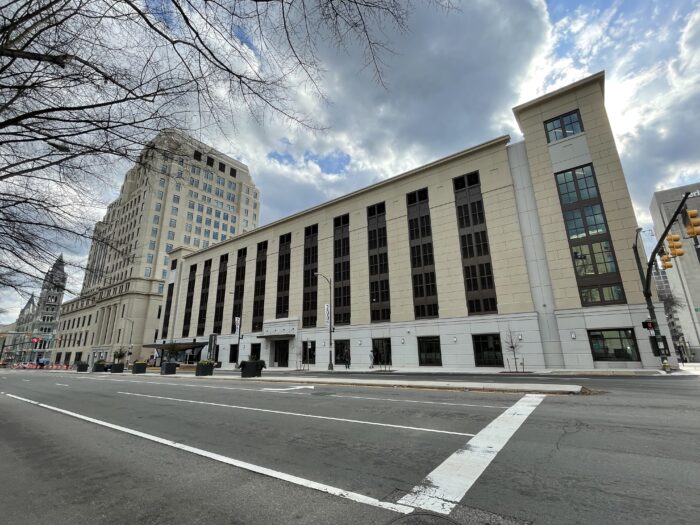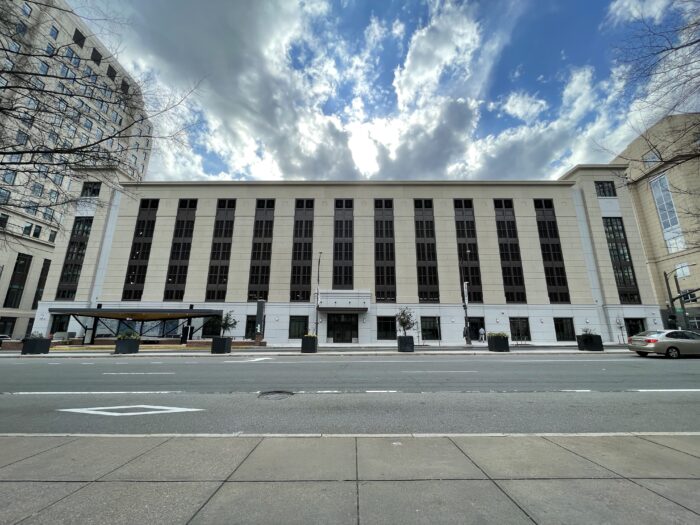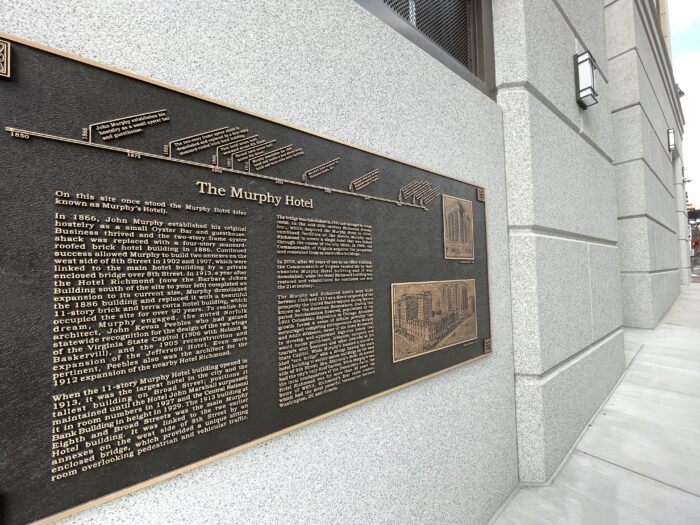
The new parking deck spans the full 800 block of East Broad Street, while the new General Assembly building rises to the east. (BizSense file photo)
How does a handsome old American burg lose its architectural character? Slowly, or in one fell swoop, depending on the neighborhood and who’s doing the pushing and pulling.
Downtown, the just-completed Commonwealth of Virginia parking garage is bordered by East Broad, North Eighth and North Ninth streets. It was designed by Commonwealth Architects. The now-demolished, former Murphy Hotel-turned Eighth Street Office Building, which had occupied the western end of the site, had inspired the scale and architectural style of the Spottswood W. Robinson III and Robert R. Merhige Jr. U.S. Courthouse, which opened in 2008 across Eighth Street (Robert A. M. Stern of New York City, architect). Sadly, the architectural conversation between those copacetic buildings was never allowed to happen.
Understandably, state officials and planners go to great lengths to maintain a Vatican City-like sanctity to Capitol Square and its immediately surrounding structures. All of these are state-owned except for St. Paul’s Episcopal Church, the Commonwealth hotel, the Eighth and Main Apartments and the Lewis F. Powell Jr. U.S. Courthouse. But look around and you’ll see that many surrounding streets have become the equivalent of back-office operations. With completion of the 500-vehicle parking garage, the 800 block of East Broad joins these previously distinctive thoroughfares as a service and support area for the Capitol.
Consider Bank Street, at the base of Capitol Square, where vehicular traffic is limited for security reasons. Former traffic lanes are cluttered by guard stations, crowd-control fencing and huge bollards that look like oversized billiard balls.
Governor Street, a winding road that evolved from old cow paths predating the city’s 18th-century grid system, is now a thicket of angled parking, a guard hut and wooden tree boxes that might better decorate a charity croquet tournament.
Up the hill, once-elegant Capitol Street is a pedestrian mall; its easternmost stretch is now a parking lot for big, black official state vehicles.
But while various office allotments, security, traffic, parking and budgetary factors necessarily fluctuate with the realities and whims of the governor and the Senate and House of Delegates, the new parking structure, with a connecting tunnel under Ninth Street, will put legislators as physically close as possible to the General Assembly Building (scheduled to open this spring). True, there’s some comfort that the blocky, Neoclassical-style garage is far better than what had been the parking norm until 2006. Until then legislators parked on the Capitol Square hillside itself, leaving tread marks in emerald lawns and antique brick sidewalks.
This deck could have been built east of Capitol Square off Governor Street, where there is ample open space.
So specifically, what was demolished in the 800 block of East Broad Street for the mausoleum-like parking deck?
Firstly, this building type shouldn’t face our town’s primary thoroughfare. It is downtown’s widest street, a mixed-use stretch of buildings including such national historical monuments as Monumental Church, First African Baptist Church and the National theater. The Miller & Rhoads Hilton, the Library of Virginia and the federal courthouse add considerably to the texture. And a blocklong parking deck is not what was promised when the recent re-do of the Capitol Square complex and planning for the courthouse were initiated earlier this century. For the courthouse, architect Stern took architectural cues from the then-still-standing, architecturally distinguished Murphy Hotel. It was designed in 1908 by Peebles and Ferguson, a Norfolk-based firm that designed the wings for the Capitol and the Virginia Museum of Fine Arts.
When the fate of Murphy’s was being discussed, the former Hotel Richmond on the opposite corner of the block was deemed worthy of rehabilitation; its excellent result is the Barbara John Building, which houses offices of the attorney general and other state legal offices. But then, like “Sophie’s Choice,” it was decided that Murphy’s (arguably the more handsome of the two) would be demolished at a cost of $4.5 million. Oh, there was guilty squirming on the part of the state. “Demolition to be done with care” read a headline in the Richmond Times-Dispatch. “Crews will salvage parts of the Eighth Street Office Building for use in its replacement, including the terra cotta cornice, limestone scrolls, sills and medallions, marble flooring, wood paneling and a cast-iron staircase,” reported Jeff E. Schapiro.
None of that happened. Instead, where the grand hotel, a pre-Civil War Italianate store and five three-story commercial buildings from the Gilded Age of the 1880s and 1890s once stood, there is now a small bronze plaque on the deck at Ninth Street that gives an account of the structures.
The tedium of the cast-stone facade is broken — and pleasantly and surprisingly so — by the sharply angled roof of a modernistic Pulse station at the western end of the block.

The new parking deck spans the full 800 block of East Broad Street, while the new General Assembly building rises to the east. (BizSense file photo)
How does a handsome old American burg lose its architectural character? Slowly, or in one fell swoop, depending on the neighborhood and who’s doing the pushing and pulling.
Downtown, the just-completed Commonwealth of Virginia parking garage is bordered by East Broad, North Eighth and North Ninth streets. It was designed by Commonwealth Architects. The now-demolished, former Murphy Hotel-turned Eighth Street Office Building, which had occupied the western end of the site, had inspired the scale and architectural style of the Spottswood W. Robinson III and Robert R. Merhige Jr. U.S. Courthouse, which opened in 2008 across Eighth Street (Robert A. M. Stern of New York City, architect). Sadly, the architectural conversation between those copacetic buildings was never allowed to happen.
Understandably, state officials and planners go to great lengths to maintain a Vatican City-like sanctity to Capitol Square and its immediately surrounding structures. All of these are state-owned except for St. Paul’s Episcopal Church, the Commonwealth hotel, the Eighth and Main Apartments and the Lewis F. Powell Jr. U.S. Courthouse. But look around and you’ll see that many surrounding streets have become the equivalent of back-office operations. With completion of the 500-vehicle parking garage, the 800 block of East Broad joins these previously distinctive thoroughfares as a service and support area for the Capitol.
Consider Bank Street, at the base of Capitol Square, where vehicular traffic is limited for security reasons. Former traffic lanes are cluttered by guard stations, crowd-control fencing and huge bollards that look like oversized billiard balls.
Governor Street, a winding road that evolved from old cow paths predating the city’s 18th-century grid system, is now a thicket of angled parking, a guard hut and wooden tree boxes that might better decorate a charity croquet tournament.
Up the hill, once-elegant Capitol Street is a pedestrian mall; its easternmost stretch is now a parking lot for big, black official state vehicles.
But while various office allotments, security, traffic, parking and budgetary factors necessarily fluctuate with the realities and whims of the governor and the Senate and House of Delegates, the new parking structure, with a connecting tunnel under Ninth Street, will put legislators as physically close as possible to the General Assembly Building (scheduled to open this spring). True, there’s some comfort that the blocky, Neoclassical-style garage is far better than what had been the parking norm until 2006. Until then legislators parked on the Capitol Square hillside itself, leaving tread marks in emerald lawns and antique brick sidewalks.
This deck could have been built east of Capitol Square off Governor Street, where there is ample open space.
So specifically, what was demolished in the 800 block of East Broad Street for the mausoleum-like parking deck?
Firstly, this building type shouldn’t face our town’s primary thoroughfare. It is downtown’s widest street, a mixed-use stretch of buildings including such national historical monuments as Monumental Church, First African Baptist Church and the National theater. The Miller & Rhoads Hilton, the Library of Virginia and the federal courthouse add considerably to the texture. And a blocklong parking deck is not what was promised when the recent re-do of the Capitol Square complex and planning for the courthouse were initiated earlier this century. For the courthouse, architect Stern took architectural cues from the then-still-standing, architecturally distinguished Murphy Hotel. It was designed in 1908 by Peebles and Ferguson, a Norfolk-based firm that designed the wings for the Capitol and the Virginia Museum of Fine Arts.
When the fate of Murphy’s was being discussed, the former Hotel Richmond on the opposite corner of the block was deemed worthy of rehabilitation; its excellent result is the Barbara John Building, which houses offices of the attorney general and other state legal offices. But then, like “Sophie’s Choice,” it was decided that Murphy’s (arguably the more handsome of the two) would be demolished at a cost of $4.5 million. Oh, there was guilty squirming on the part of the state. “Demolition to be done with care” read a headline in the Richmond Times-Dispatch. “Crews will salvage parts of the Eighth Street Office Building for use in its replacement, including the terra cotta cornice, limestone scrolls, sills and medallions, marble flooring, wood paneling and a cast-iron staircase,” reported Jeff E. Schapiro.
None of that happened. Instead, where the grand hotel, a pre-Civil War Italianate store and five three-story commercial buildings from the Gilded Age of the 1880s and 1890s once stood, there is now a small bronze plaque on the deck at Ninth Street that gives an account of the structures.
The tedium of the cast-stone facade is broken — and pleasantly and surprisingly so — by the sharply angled roof of a modernistic Pulse station at the western end of the block.






Well written, as always, Edwin! It’s now such a useless block and I personally dislike any kind of tunnel or bridge for pedestrians, especially legislators, since it removes street life. Politicians need to be accountable for their actions and now they won’t even encounter people when going to/from the General Assembly while it’s in session.
Speaking of street life, in 2018 DGS was talking about the possibility of street level commercial activity/retail space is that open for consideration??
Classic album cover.
There are 2 large tenant spaces along the entire ground level floor of the north elevation (Broad Street side)
Great article. This parking deck is a slap in the face of the people of Richmond. The State of Virginia has been a very poor steward of their land in the city in recent decades and has fallen far below the high standards set earlier in the development of capitol square.
With the issues for bicycle and pedestrian connectivity on Bank St., I also had been thinking about just how poorly the State Government addresses the city. Old articles I found about how dense and interesting the area was in the past makes it sad to see nothing but blank concrete facades. Maybe with the surplus declaration of the Department of Education building and (potential?) demolition there will be chances to improve the area. (I do like that building, just not how it addresses the street)
The loss of free movement around, and through, Captiol Square is one of the great losses of not only Downtown but the entire region. Add to that the continued privatization–and militarization–of the Square and you get a massive hole in the heart of the city that literally and figuratively turns its back on the city. I can’t tell you how many times I had conversations with the Commonwealth to take measures during project planning to be more open to the surrounding community and to make a real statement about its relationship to Richmond as a place through keeping streets open,… Read more »
Many will remember that Mayor Wilder spoke at the ACORN protest rally to save the Murphy Hotel. He envisioned retrofitting the building as an urban law campus.
After what happened to Monument Ave, how could anyone expect the dictators in charge to care about the historical integrity of our city.
Heavy sigh- The aesthetic of the parking deck makes me wince every time I drive by…Thanks to Ed Slipek for chronicling this sad new reality.
Poor planning, poor design, poor execution, and a generational mistake imposed on the people of Richmond.
Ed, my old friend from Style Weekly, is right on. It’s the gradual and seemingly willful transformation of Richmond into Anywhere, USA.
Oh, boy! Here we go!! “Every nice old building must be saved!” “We don’t need car infrastructure — make everyone ride the bus!” Etc. I’ve seen a LOT of parking garages, and only a few that were at all nice — this one is one of the nicer ones that I have seen, and I wish they were ALL this nice, and not just when politicians want there to be dignity paid for by the taxpayer. I mean, sure, it is EASY when you aren’t one of the ones who have to solve the most pressing problems (which NEVER have… Read more »
Richmond: A city in spite of itself.
Wasn’t the Capitol addition designed by Peebles & Baskervill?
Excellent observations; a parking deck (regardless of the handsome design) should never have been built on Broad Street. At a minimum, there should have been first floor retail. Unfortunately, the State does pretty much what it wants without regard for good urban planning.
There are 2 tenant spaces along Broad Street – the entire elevation
Excellent commentary by Dr. Slipek. I can’t come up with enough “family-friendly” ways of saying how utterly disappointing that THIS is the fate of this block of E. Broad St. Once again, it’s a fine example of the state being the state and fumbling at the goal line. I suppose the state needed a horrific miscue to counterbalance the HUGE home run it’s hitting with the handsome, beefy, newly proposed courts building on 10th between E. Main and Bank streets. I’m no preservationist by any stretch – and yet for the life of me, I STILL can’t wrap my head… Read more »
The powers that be in Richmond, showing up hard hearted and lackadaisical to their seats, stripping character and history away from our city along with it’s potential every single day. We can be doing so much better than this. Fortunately and unfortunately, life is full of decisions. The decisions Richmond make, makes Richmond.